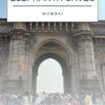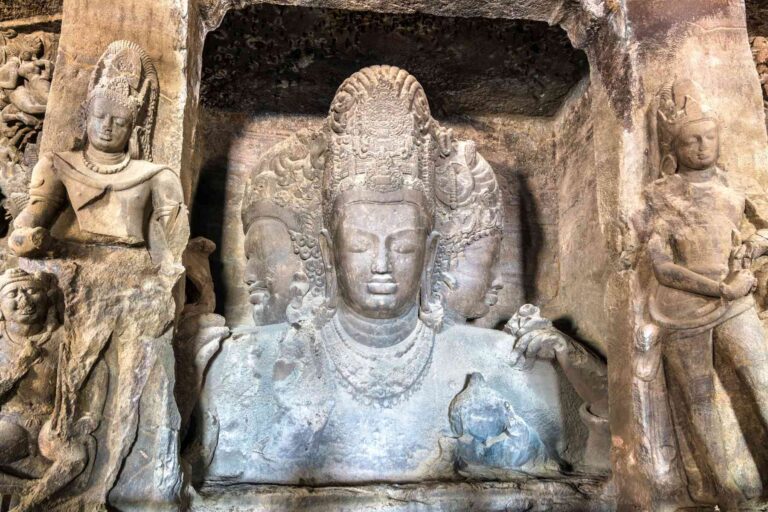
Go World Travel is reader-supported and may earn a commission from purchases made through links in this piece.
Mumbai, the excitable metropolis capital of Maharashtra state, on the shores of the Arabian Sea in western India, is the “city of dreams.” It is a city of opportunities and freedom. Bombay, as it was known until 1995, found its footing as an important trading town under the Portuguese in the 16th century.
Over the centuries, what was once a group of seven islands ruled by a succession of local kings and dynasties, culminating, of course, with the British Empire, has evolved into a sprawling megacity.
Mumbai has become famous as the financial capital of India and the home of Bollywood, the expansive Hindi film industry. It is also home to many historic and cultural landmarks that are testimonies to its many remarkable eras.
Best Tips & Tools to Plan Your Trip
A November Vacation
My husband and I reached Mumbai just the night before for a simple November vacation when, mercifully, the infamous humidity was non-existent, and a milder, cooler air pervaded the city.
Our aim was to visit a few of the historic sites in the short time we had on our hands, and we commenced our sightseeing with a visit to the UNESCO World Heritage Site of Elephanta Island.
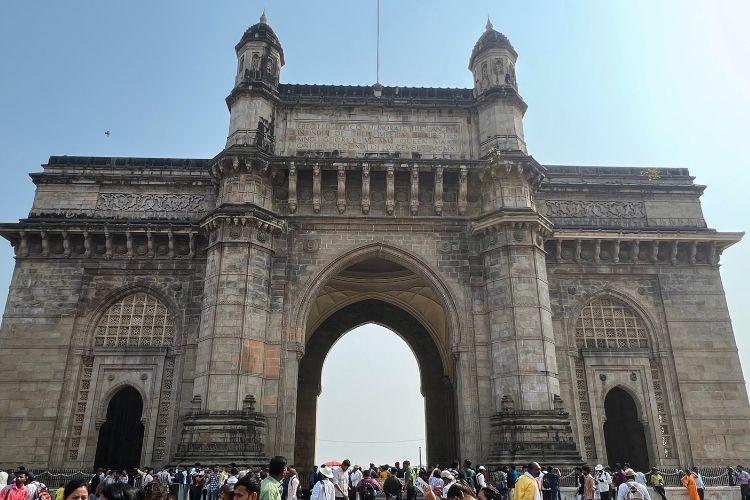
First, the Art Deco
As we waited at a street corner for the lights to turn pedestrian-friendly, I turned around and looked at the building behind us; it was a movie hall—how appropriate for a city synonymous with Bollywood.
On closer inspection, I noticed the UNESCO World Heritage plaque. This was the Regal Cinema, built in 1933 in the Art Deco style, a highly popular design style of many Mumbai buildings.
Regal was part of a group of Art Deco buildings that belong to an ensemble of Victorian Gothic and Art Deco buildings that received World Heritage status in 2018.
Iconic Mumbai Landmarks
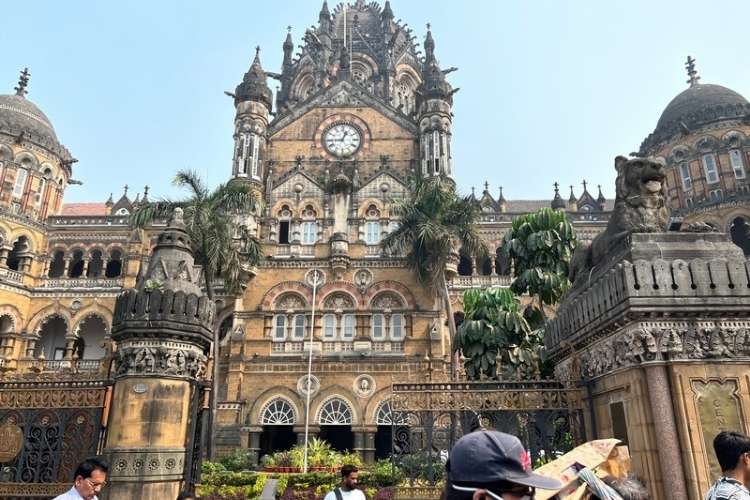
We crossed the busy Chhatrapati Shivaji Maharaj Marg for a short 7-minute walk to Apollo Bunder and towards that famous Mumbai landmark, the Gateway of India, and the boarding point for the Elephanta ferry.
Soon, we were in a gigantic plaza on Mumbai harbor, ornamented by two massive statues. To my left was Swami Vivekananda, a Hindu monk, philosopher, and reformer from 19th-century Bengal, a faraway state on the eastern coast of India.
Why was his statue here? In 1893, he boarded the steamer from where the Gateway would later be erected to travel to Chicago for the World Parliament of Religions, where he would make a historic speech introducing Hinduism, Vedanta philosophy, and yoga to the West.
On the right was the equestrian statue of Chhatrapati Shivaji Maharaj, the Maratha warrior king who laid the foundation of the Maratha Empire, a veritable force in Indian history that the British East India Company defeated.
As is the case in many places in India, the statue here, too, replaced an older statue of King George V in 1961.
In front of me, dominating the plaza, was the Gateway of India, an architectural jewel of Indo-Saracenic style hugging the Arabian Sea. Built in 1911, it commemorated the visit of King George V and Queen Mary for their formal proclamation as the Emperor and Empress of India at the Delhi Durbar.
The Grandeur of the Taj Mahal Palace Hotel
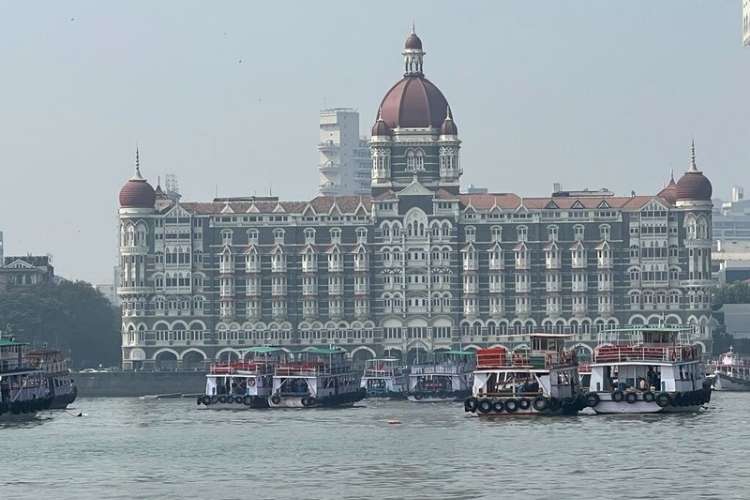
Turning around from the gate and facing the road, I admired the other iconic landmark, the Taj Mahal Palace Hotel, which opened in 1903, predating the Gateway. The luxurious palatial hotel, with its legendary red domes and extravagant Indo-Saracenic style of architecture, can still stop people in their tracks.
Enter the hotel to experience its regal splendor. Admire the wall-length mural painting behind the reception desk. It is an artwork by M. F. Husain (1915-2011), an eminent modernist Indian painter well known for his abstract, colorful canvases. I found out these paintings were redone by Husain after the originals were destroyed in the infamous Mumbai terrorist attacks of 2008.
Take a walk through the corridors adjoining the lobby to step into a historical era exhibited through photographs. You will find walls adorned with photos of the world’s luminaries who stayed here on their visits to India.
Continue on to be charmed by many more such pictures on the walls of their all-day restaurant. We took a walk inside to admire the gorgeously regal staircase, the magnificent galleries, and intricately detailed balustrades.
Check out the hotel website here.
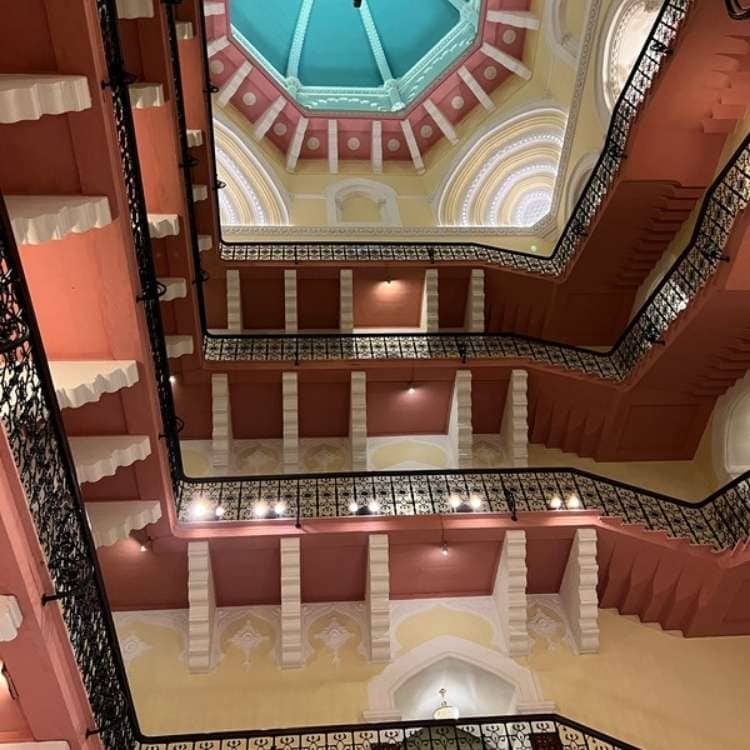
Starting for Elephanta Island
We boarded our ferry from the Gateway plaza and realized it was already jam-packed—we were the last ones to step in. We settled in amongst a few early bird tourists and locals as the ferry started its 1-hour journey on the Arabian Sea.
As we sailed further into the sea, the water became clear, a bunch of seagulls joined the ferry flying alongside, and a distant forested island came into view. Soon our ferry pulled into the jetty, and we stepped off the boat and boarded a tourist toy train that took us from the dock to the entrance area for Elephanta.
Getting off the train, we got our entry tickets and headed to the caves. But first, there were steps to climb, 120 in all. We climbed uphill, stalls on either side selling trinkets, handmade jewelry, decor items made of shells, and inexplicably, toy guns.
At times, monkeys darted by. At long last, we reached the top, and the vista was breathtaking. The Arabian Sea looked calm and beautiful from our vantage point, and there to my right were gigantic pillars cut into solid rock, the entrance into the first cave of Elephanta.
First Impressions of Elephanta Caves
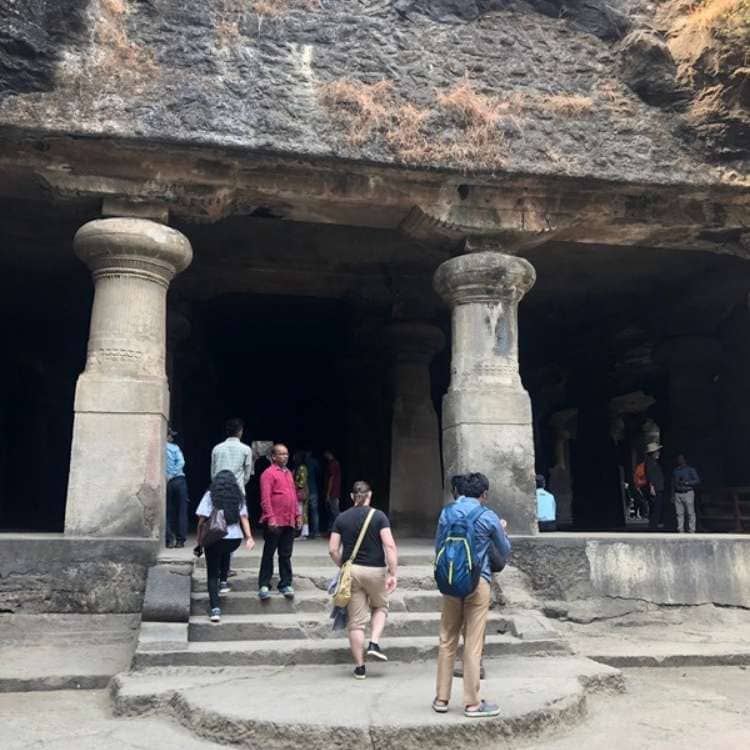
The caves on Elephanta Island or Gharapuri, meaning city of caves as it is known locally, were built between the 5th and 7th centuries AD. There are seven rock-cut caves in all, with architectural influences of the Chalukyan and Gupta periods, along with a few Buddhist stupa mounds that date to the 2nd century BC.
The Buddhist caves are reachable by another boat ride, but the primary attraction here is the five Hindu cave temples.
Elephanta owes its name to the Portuguese navigators who arrived in the Bombay area in the 16th century. Landing on this island, they came upon a gigantic rock-cut elephant statue near the spot where they docked and thus named the place “Ilha Elefante.”
According to history, the British, who later ruled India, tried to ship off the elephant to England, broke it, and abandoned the idea, having failed in their attempt. Today the broken elephant sits in a garden in Mumbai.
A Tour of the Caves Beginning at the Great Cave
We began at cave number 1, known as the Great Cave. It is definitely the best-preserved one, which contributed to the island receiving its World Heritage status in 1987. There are three entrances to this monolithic cave temple. The main north entrance has four pillars, creating a portico entry.
I could see nothing but inky darkness as we proceeded towards the entrance. I stepped into an expansive hall supported by gigantic but elegantly carved columns. Sunlight was cascading in.
Immediately to my left and right, embedded into the rock, were Shiva sculptures: Yogeshvara, the Lord of yoga, on the left and the highly popular form, Nataraja, or the cosmic dancing god, on the right. Shiva’s face in each colossal sculpture exuded beautiful serenity.
Experiencing the Multitude of Shiva
The Great Cave is exclusively devoted to Shiva, the Hindu god primarily known as The Destroyer. But in this cave, one gets to see the myriad forms of Shiva, and it is an unforgettable experience.
We walked through the enormous hall or mandapa, the gathering area in a Hindu temple, and marveled at the carvings sculpted into the grayish, basalt rocks, creating a sublime masterpiece.
A lot of it is also in ruins, destroyed by the invading Sultanates, the Portuguese, and the British, but somehow a majority of the cave sculptures have survived in good condition.
Stop to enter the main, square temple, a simple, plain structure with entrances on all sides guarded by ceiling-high Dvarapala statues and the temple guards, two at each gate.
Remember to take off your footwear, as this is a traditional Hindu temple, to enter the inner sanctum, the garbha griha, wherein was that omnipresent Shiva shrine, the Shivalinga, or the phallic form. This temple is on an east-west axis so that the sun could stream into the innermost space illuminating the shrine early in the morning.
Circumambulation to See the Sculptures
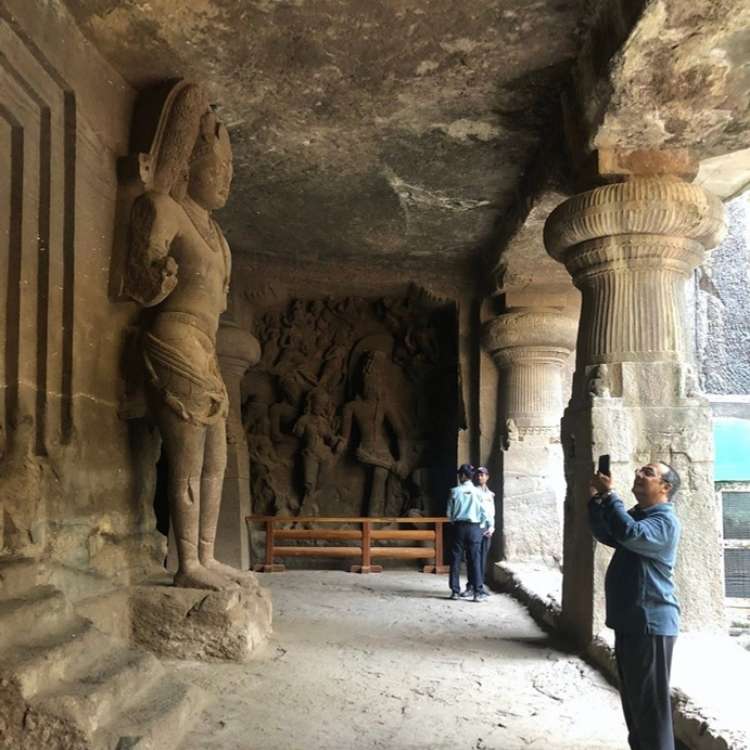
Though the cave is not used as a temple anymore, as tourists, we still had to follow the devotional practice of pradakshina, or the circumambulation process.
The walls around were resplendent with friezes – a sweeping, intricately detailed carving showed the marriage of Shiva and Parvati, his consort. While Shiva had a quietly confident and serene expression, the goddess Parvati’s eyes were downcast with a shy air.
The details were exquisite. The expansive sculpture had a variety of gods, and I spotted Ganesha, the god with the elephant head (and also a son of Shiva and Parvati), and other heavenly beings in attendance for the wedding. On one corner, there was Brahma, the Creator, officiating the ceremony.
Other panels highlighted the different legends of Shiva. One showed him in his fierce form, Bhairava, destroying a demon; another showed Shiva and Parvati at their abode, Mount Kailash. Still, another had a scene from the Ramayana, with Ravana, the demon king, trying to lift Mount Kailash with Shiva Parvati on it and being unsuccessful.
But sadly, these are the sculptures that were heavily damaged in bygone eras. The Ardha – Narishwara panel showed the most interesting male-female aspect of Shiva, exemplifying the importance of both principles.
Seeing the Trimurti
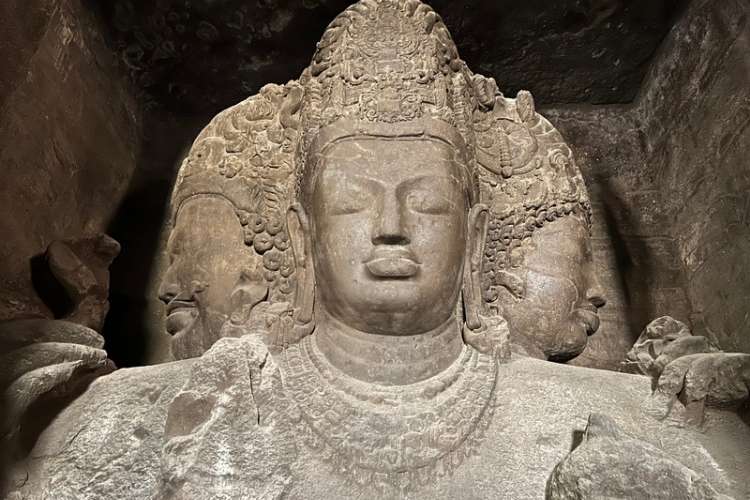
Now we were in front of the pièce de résistance of the Great Cave. The Trimurti is a sculpture that is immediately familiar to most Indians, including those who have never been to Elephanta. It is also one that did not suffer any damage in earlier times. Facing the north entrance, the famous Trimurti (The Trinity) shows three faces of Lord Shiva.
According to scholars, this form actually shows five faces or Panchmukhi Shiva, where two faces are unseen, but in any case, only three are visible to us mere mortals. Also known as Sadashiv Maheshmurti, the three faces highlight the creation, protection, and destruction of life and are truly a triumph of ancient sculpture.
Interestingly enough, it only took a few minutes to look at the other caves, two to be exact, as two others are inaccessible to visitors. But the other two needed just a walk past as they were left incomplete by the ancients. No one knows why.
Find out all about visiting Elephanta Island here.
Admiring A Railway Terminus
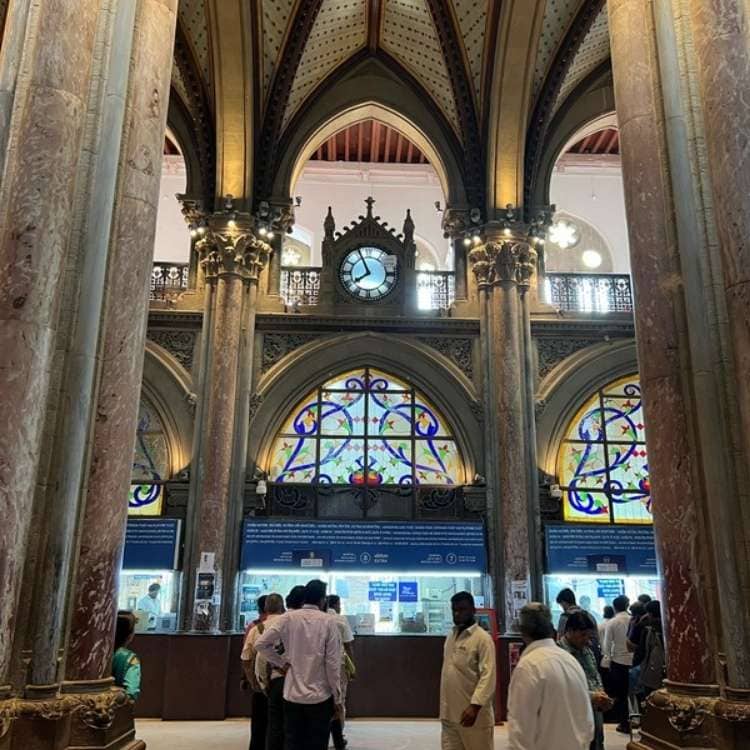
Once we came back to the mainland, we decided to extend our day of tourism by visiting another UNESCO World Heritage Site. The Chhatrapati Shivaji Maharaj Railway Terminus, inscribed by UNESCO in 2004, known as Victoria Terminus until 1996, is another indelible Mumbai landmark.
Instantly recognizable from countless Bollywood movies and from the Oscar-winning movie Slumdog Millionaire as the venue of the Oscar winner song “Jai Ho,” this architectural marvel of a railway terminal was built in 1888 in the spectacularly effervescent Victorian Gothic Revival style mixed with Hindu and Islamic styles.
We took a stroll inside to admire the superb stained glass windows, the ornamental iron and brass railings, the incredible wood carvings, the phenomenal high central dome, and the many statues and friezes. Outside, the terminus mimics a fairytale-like palace with turrets, arches, buttresses, and many decorative elements.
And so, we completed our day of sightseeing in Mumbai and came away enriched by the history and aesthetics of incredible architecture, eternal in time, found in this city of dreams known for its glamor.
Find lots more information on visiting Mumbai at websites — Viator and MakeMyTrip.
Inspire your next adventure with our articles below:
Author Bio: Susmita Sengupta, an architect by background, is a freelance writer based in New York, who loves to travel with her family. She has written for GoNomad, Go World Travel, Matador Network and many other web based travel magazines.
- Discover Claremont, California Along Historic Route 66 - December 6, 2024
- Three Sites to Soothe the Soul in Kyoto, Japan - December 5, 2024
- 13 Essential Tips For Women Traveling in Morocco - December 4, 2024

